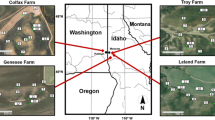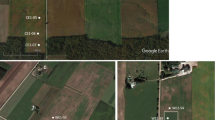Abstract
In-season nitrogen (N) management of irrigated maize (Zea mays L.) requires frequent acquisition of plant N status estimates to timely assess the onset of crop N deficiency and its spatial variability within a field. This study compared ground-based Exotech nadir-view sensor data and QuickBird satellite multi-spectral data to evaluate several green waveband vegetation indices to assess the N status of irrigated maize. It also sought to determine if QuickBird multi-spectral imagery could be used to develop plant N status maps as accurately as those produced by ground-based sensor systems. The green normalized difference vegetation index normalized to a reference area (NGNDVI) clustered the data for three clear-day data acquisitions between QuickBird and Exotech data producing slopes and intercepts statistically not different from 1 and 0, respectively, for the individual days as well as for the combined data. Comparisons of NGNDVI and the N Sufficiency Index produced good correlation coefficients that ranged from 0.91 to 0.95 for the V12 and V15 maize growth stages and their combined data. Nitrogen sufficiency maps based on the NGNDVI to indicate N sufficient (≥0.96) or N deficient (<0.96) maize were similar for the two sensor systems. A quantitative assessment of these N sufficiency maps for the V10–V15 crop growth stages ranged from 79 to 83% similarity based on areal agreement and moderate to substantial agreement based on the kappa statistics. Results from our study indicate that QuickBird satellite multi-spectral data can be used to assess irrigated maize N status at the V12 and later growth stages and its variability within a field for in-season N management. The NGNDVI compensated for large off-nadir and changing target azimuth view angles associated with frequent QuickBird acquisitions.





Similar content being viewed by others
References
Bausch, W. C., & Delgado, J. A. (2003). Ground-based sensing of plant nitrogen status in irrigated corn to improve nitrogen management. In T. Van Toai, D. Major, M. McDonald, J. Schepers, & L. Tarpley (Eds.), Digital imaging and spectral techniques: Applications to precision agriculture and crop physiology, ASA Special Publication 66 (pp. 145–157). Madison, WI, USA: ASA, CSSA, SSSA.
Bausch, W. C., & Delgado, J. A. (2005). Impact of residual soil nitrate on in-season nitrogen applications to irrigated corn based on remotely sensed assessments of crop nitrogen status. Precision Agriculture, 6, 509–519.
Bausch, W. C., & Diker, K. (2001). Innovative remote sensing techniques to increase nitrogen use efficiency of corn. Communications in Soil Science and Plant Analysis, 32, 1373–1390.
Bausch, W. C., & Duke, H. R. (1996). Remote sensing of plant nitrogen status of corn. Transactions of the American Society of Agricultural Engineers, 39, 1869–1875.
Bausch, W. C., Halvorson, A. D., & Cipra, J. (2008). QuickBird satellite and ground-based multispectral data correlations with agronomic parameters of irrigated maize grown in small plots. Biosystems Engineering, 101, 306–315.
Beyer, H. L. (2007). Hawth’s analysis tools for ArcGIS. Version 3.27. http://www.spatialecology.com/htools/index.php. Last visited 22 October 2008.
Blackmer, T. M., & Schepers, J. S. (1995). Use of a chlorophyll meter to monitor nitrogen status and schedule fertigations for corn. Journal Production Agriculture, 8, 56–60.
Blackmer, T. M., Schepers, J. S., & Varvel, G. E. (1994). Light reflectance compared with other nitrogen stress measurements in corn leaves. Agronomy Journal, 86, 934–938.
Blackmer, T. M., Schepers, J. S., Varvel, G. E., & Walter-Shea, E. A. (1996). Nitrogen deficiency detection using reflected shortwave radiation from irrigated corn canopies. Agronomy Journal, 88, 1–5.
Blackmer, T. M., Schepers, J. S., & Vigil, M. F. (1993). Chlorophyll meter readings in corn as affected by plant spacing. Communications in Soil Science and Plant Analysis, 24, 2507–2516.
DigitalGlobe. (2001). QuickBird satellite launches successfully. GeoWorld, 14, 11.
Duggin, M. J. (1980). The field measurement of reflectance factors. Photogrammetric Engineering and Remote Sensing, 46, 643–647.
Everitt, J. H., Yang, C., Fletcher, R. S., & Deloach, C. J. (2007). Comparison of QuickBird and SPOT-5 satellite imagery for mapping giant reed. Journal of Aquatic Plant Management, 46, 77–82.
Gitelson, A. A., Kaufman, Y. J., & Merzlyak, M. N. (1996). Use of a green channel in remote sensing of global vegetation from EOS-MODIS. Remote Sensing of the Environment, 58, 289–298.
Gitelson, A. A., Vina, A., Ciganda, V., Rundquist, D. C., & Arkebauer, T. J. (2005). Remote estimation of canopy chlorophyll content in crops. Geophysical Research Letters, 32, L08403. doi:10.1029/2005GL022688.
Godwin, R. J., James, I. T., Welsh, J. P., & Earl, R. (1999). Managing spatially variable nitrogen: A practical approach. Paper No. 991142. ASAE, St. Joseph, MI, USA.
Hornung, A., Khosla, R., Reich, R., Inman, D., & Westfall, D. (2006). Comparison of site-specific management zones: Soil color based and yield based. Agronomy Journal, 98, 405–417.
Inman, D., Khosla, R., Reich, R., & Westfall, D. G. (2008). Normalized difference vegetation index and soil color-based management zones in irrigated maize. Agronomy Journal, 100, 60–66.
Jackson, R. D., Moran, M. S., Slater, P. N., & Biggar, S. F. (1987). Field calibration of reference reflectance panels. Remote Sensing of the Environment, 22, 145–158.
Jackson, R. D., Teillet, P. M., Slater, P. N., Fedosejevs, G., Jasinski, M. F., Aase, J. K., et al. (1990). Bidirectional measurements of surface reflectance for view angle corrections of oblique imagery. Remote Sensing of the Environment, 32, 189–202.
Jenness, J., & Wynne, J. J. (2007). Kappa analysis (kappa_stats.avx) extension for ArcView 3.x. Jenness Enterprises. http://www.jennessent.com/arcview/kappa_stats.htm. Last visited 21 October 2008.
Khosla, R., Fleming, K., Delgado, J. A., Shaver, T. M., & Westfall, D. G. (2002). Use of site-specific management zones to improve nitrogen management for precision agriculture. Journal of Soil and Water Conservation, 57, 513–518.
Khosla, R., Inman, D., Westfall, D., Riech, R., Frasier, W. M., Mzuku, M., et al. (2008). A synthesis of multi-disciplinary research in precision agriculture: Site-specific management zones in the semi-arid western Great Plains of the USA. Precision Agriculture, 9, 85–100.
Koch, B., Khosla, R., Westfall, D. G., Frasier, W. M., & Inman, D. (2004). Economic feasibility of variable rate N application in irrigated corn. Agronomy Journal, 96, 1572–1580.
Landis, R. J., & Koch, G. G. (1977). The measurement of observer agreement for categorical data. Biometrics, 33, 159–174.
McMurtrey, J. E., I. I. I., Chappelle, E. W., Kim, M. S., Meisinger, J. J., & Corp, L. A. (1994). Distinguishing nitrogen fertilization levels in field corn (Zea mays L.) with actively induced fluorescence and passive reflectance measurements. Remote Sensing of the Environment, 47(3), 6–44.
Moran, M. S., Jackson, R. D., Hart, G. F., Slater, P. N., Bartell, R. J., Biggar, S. F., et al. (1990). Obtaining surface reflectance factors from atmospheric and view angle corrected SPOT-1 HRV data. Remote Sensing of the Environment, 32, 203–214.
Moran, M. S., Jackson, R. D., Slater, P. N., & Teillet, P. M. (1992). Evaluation of simplified procedures for retrieval of land surface reflectance factors from satellite sensor output. Remote Sensing of the Environment, 41, 169–184.
Mortvedt, J. J., Westfall, D. G., & Croissant, R. L. (1996). Fertilizing corn. Fact Sheet 0.538. Fort Collins, CO, USA: Colorado State University Cooperative Extension.
Mzuku, M., Khosla, R., Reich, R., Inman, D., Smith, F., & MacDonald, L. (2005). Spatial variability of measured soil properties across site specific management zones. Soil Science Society of America Journal, 69, 1572–1579.
Narsavage, D., Gentry, C., & Weber, K. T. (2008). White paper report: A comparison of NDVI models generated using QuickBird and Landsat7 ETM+ data. Idaho State University, Pocatello, ID 83209. http://giscenter.isu.edu/research/techpg/blm_fire/NDVI_Report.pdf. Last visited 18 October 2008.
Peterson, T. A., Blackmer, T. M., Francis, D. D., & Schepers, J. S. (1993). Using a chlorophyll meter to improve N management. NebGuide G93–1171-A, Lincoln. Lincoln, NE, USA: Cooperative Extension, Institute of Agriculture and Natural Resources, University of Nebraska.
Pinter, P. J., Jr., Jackson, R. D., & Moran, M. S. (1990). Bidirectional reflectance factors of agricultural targets: A comparison of ground-, aircraft-, and satellite-based observations. Remote Sensing of the Environment, 32, 215–228.
Ritchie, S. W., Hanaway, J. J., & Benson, G. O. (1986). How a corn plant develops. Specialty Report 48. Ames, IA, USA: Iowa State Extension Service, Iowa State University.
Rouse, J. W., Haas, R. H., Schell, J. A., & Deering, D. W. (1973). Monitoring vegetation systems in the Great Plains with ERTS. In: Third ERTS Symposium, Washington DC, USA. NASA SP-351 I: 309–317.
Satellite Imaging Corporation. (2008). http://www.satimagingcorp.com/satellite-sensors/quickbird.html. Last visited 18 October 2008.
Schepers, J. S. (1994). New diagnostic tools for tissue testing. Communication in Soil Science and Plant Analysis, 25, 817–826.
Schepers, J. S., Blackmer, T. M., Wilhelm, W. W., & Resende, M. (1996). Transmittance and reflectance measurements of corn leaves from plants differing in nitrogen and water supply. Journal of Plant Physiology, 148, 523–529.
Schepers, J. S., Francis, D. D., Vigil, M. F., & Below, F. E. (1992). Comparison of corn leaf nitrogen concentration and chlorophyll meter readings. Communications in Soil Science and Plant Analysis, 23, 2173–2187.
Schleicher, T. D. (2001). Application and evaluation of the nitrogen reflection index (NRI) for site-specific fertilizer management. MS Thesis, Colorado State University, Ft. Collins, CO, USA.
Schleicher, T. D., Bausch, W. C., & Delgado, J. A. (2003). Low groundcover filtering to improve reliability of the nitrogen reflectance index (NRI) for corn N status classification. Transactions of the American Society of Agricultural Engineers, 46, 1701–1711.
Shanahan, J. F., Holland, K. H., Schepers, J. S., Francis, D. D., Schlemmer, M. R., & Caldwell, R. (2003). Use of a crop canopy reflectance sensor to assess corn leaf chlorophyll content. In T. Van Toai, D. Major, M. McDonald, J. Schepers, & L. Tarpley (Eds.), Digital imaging and spectral techniques: Applications to precision agriculture and crop physiology, ASA Special Publication 66 (pp. 135–150). Madison, WI, USA: ASA, CSSA, SSSA.
Soil Survey Staff. (1981). Soil survey of Yuma County, Colorado. Washington, DC, USA: USDA Cooperative Soil Survey. US Government Printing Office.
Solari, F., Shanahan, J., Ferguson, R., Schepers, J., & Gitelson, A. (2008). Active sensor reflectance measurements of corn nitrogen status and yield potential. Agronomy Journal, 100, 571–579.
Varvel, G. E., Schepers, J. S., & Francis, D. D. (1997). Ability of in-season correction of nitrogen deficiency in corn using chlorophyll meters. Soil Science Society of America Journal, 59, 1233–1239.
Wang, L., Sousa, W. P., Gong, P., & Biging, G. S. (2004). Comparison of IKONOS and QuickBird images for mapping mangrove species on the Caribbean coast of Panama. Remote Sensing of the Environment, 91, 432–440.
Weisberg, S. (1980). Applied linear regression. New York, NY, USA: Wiley.
Wu, J., Wang, D., & Bauer, M. E. (2005). Image-based atmospheric correction of QuickBird imagery of Minnesota cropland. Remote Sensing of the Environment, 99, 315–325.
Yang, C., Everitt, J., & Bradford, J. (2006). Comparison of QuickBird satellite imagery and airborne imagery for mapping grain sorghum yield patterns. Precision Agriculture, 7, 33–44.
Acknowledgments
The authors thank DigitalGlobe for providing QuickBird satellite images for this study and Dr. Jack F. Paris for assistance in obtaining the images. Special thanks go to Kenan Diker, Bryan Brown and Mary Brodahl for the image and spatial data analysis required in this study.
Author information
Authors and Affiliations
Corresponding author
Additional information
Disclaimer Mention of trade names or commercial products is solely for the purpose of providing specific information and does not imply recommendation or endorsement by the US Department of Agriculture or Colorado State University.
Rights and permissions
About this article
Cite this article
Bausch, W.C., Khosla, R. QuickBird satellite versus ground-based multi-spectral data for estimating nitrogen status of irrigated maize. Precision Agric 11, 274–290 (2010). https://doi.org/10.1007/s11119-009-9133-1
Received:
Accepted:
Published:
Issue Date:
DOI: https://doi.org/10.1007/s11119-009-9133-1




